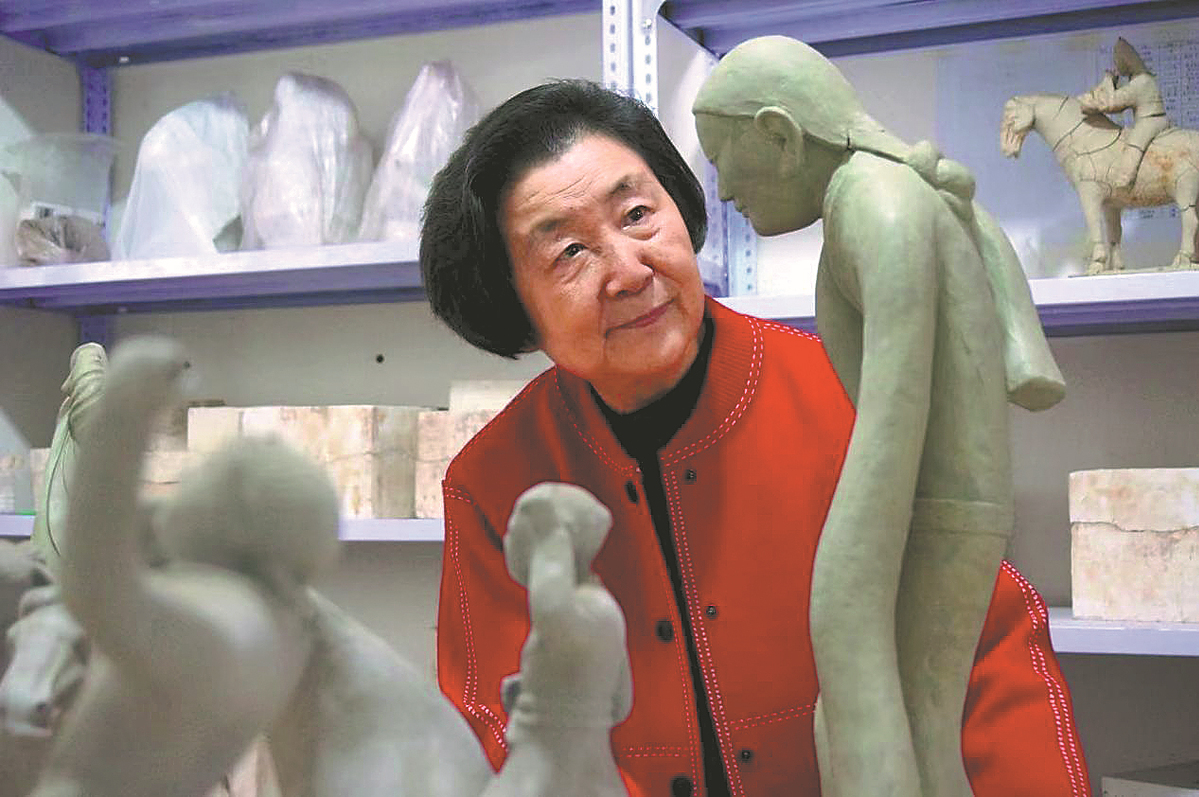Terracotta artist rekindles lost light on ancient skills
From:China DailyAuthor: 2024-01-11 15:39

Wang Qian examines a figurine in her workshop in Xi'an, Shaanxi province. [Photo provided to China Daily]
The creator of the world's first life-size Terracotta Warrior replica in 1979 is as passionate as ever about historical sculpture today as she was over 40 years ago.
Wang Qian, 79, talks excitedly about her most recent terracotta replicas and recreations of musical and dancing figurines made real once more from pictures of the originals that have been looted or ruined, after being interpreted from descriptions in ancient texts and partial fragments found in museums.
"Look at this girl on the horse. She's got such an amazing presence and carries herself with such confidence and style," she said, pointing to one particular figurine carved into a spirited posture.
More than 100 different sets of figures were created by Wang and her team from 2015 to 2020, counting more than 350 altogether. They have breathed new life into what was ancient lost art and culture of China.
An exhibition in Xi'an, which opened in November, is displaying about a tenth of the replicas.
Despite Wang being a master of arts and crafts, reproducing terracotta pieces from ancient times is no easy task.
"The process of replicating terracotta figures is complex and challenging. From preparing the clay to shaping, molding, firing, coloring and aging, each step must be executed with precision and care," she said.
Terracotta figures gradually fell out of favor during the Ming Dynasty (1368-1644) and many of the original techniques were lost. It was a significant loss for Chinese culture.
"Replicating musical and dancing figurines is not just about externalizing the physical forms, but also about the continuity and promotion of traditional culture," she said.
Over the past four decades, Wang has developed a complete set of techniques for replicating painted terracotta sculptures — some small, some large — and has duplicated more than 6,000 pieces.
The connection between Wang and the art of painted terracotta is similar to the process of making the figures themselves — it is an art that takes shape through repeated exploration and contemplation.
Wang was born into a family of artists. Her father, Wang Ziyun, was a renowned painter, sculptor and a pioneer in China's earliest modern fine arts movement. He studied sculpture in France in the 1940s and later returned to China, where he advocated for the establishment of professional teams in art archaeology as part of cultural preservation efforts. Wang's mother also participated in those efforts.
Influenced by her family, Wang nurtured a passion for preserving cultural heritage. She studied at a school of fine art in Xi'an and worked as a researcher at the Xi'an Beilin Museum for more than 20 years before retiring in 2000 — a period during which she produced thousands of terracotta replicas.
In 1979, she produced the world's first life-size Terracotta Warrior replica, creating a sensation at home and abroad. Her works were presented as national gifts to former French president Francois Mitterrand and have won numerous awards.
In 1995, Wang's series of pottery figurines of ancient Chinese dancers won the gold award at the 44th Eureka World Invention Exhibition in Brussels, Belgium, igniting a Chinese culture frenzy.
The musical and dancing figurines provide a visual representation of the social life and aesthetics of ancient China, Wang said. She believes that the figurines are a crucial part of cultural heritage and play a significant role in preserving and promoting traditional Chinese culture.
She has led many students on visits to various museums to observe pieces from different eras, explaining their characteristics and analyzing and comparing their sculptural features and production techniques.
"I am passing on the baton of cultural inheritance and cultural awareness to my students," she said.
"I want to compile my 40 years of experience into a book and interpret the history of ancient Chinese music and dance from the perspective of pottery figurines, ensuring the long-lasting inheritance of these traditional techniques for creating painted terracotta figurines."
Edit:董丽娜
The copyright of the article and the picture belongs to the original author. If there is any infringement, please contact to delete it